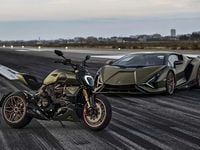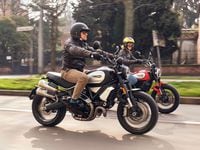Over the years, motorcycle manufacturers have found inspiration from their back catalogs of greatness: the Honda GB500, the Kawasaki ZRX1100, the Ducati Sport 1000. Decades removed, they’ve become classics based on classics. But the retro category really picked up steam in the last decade or two, with nearly every OEM offering some sort of retro ride and for every budget.
Nostalgia has a mighty pull. The world of motorcycling isn’t immune to the heart’s sway toward a rose-colored past. Maybe it’s because we want the motorcycles we loved but couldn’t afford when we were young. Or maybe we romanticize a past not our own, drawn to an era devoid of the problems of our time.
Maybe it’s nothing so pathological. Perhaps it’s just that classic design elements have timeless and universal appeal. We’re gearheads for a reason: We’re drawn to the mechanical nature of the motorcycle. An exposed engine, a teardrop-shaped gas tank around which to wrap one’s knees, a round headlight leading the charge: That’s what motorcycles are supposed to look like, some would say. There’s a tipping point, undoubtedly, when throttle bodies disguised as carburetors or faux cooling fins can morph into playacting. But, as our selections show, OEMs have done an admirable job of finding the balance. We love that there’s a vintage-to-modern spectrum of motorcycles available on the market. From air-cooling to liquid-cooling, from cable throttles to ride-by-wire, riders have options when it comes to selecting their version of the best of both worlds.
In 2025, “retro” is relative. And regardless of budget, there’s a retro roadster that fits the bill.
We’re not sure what’s more impressive: the Triumph Speed 400′s low $5195 price tag, or how good it is regardless of the price.
The specs offer little insight into the Speed 400′s excellence. It uses a DOHC liquid-cooled single that Triumph claims produces 39.5 hp at 8000 rpm and 27.7 lb.-ft. of torque at 6500 rpm. Ride-by-wire throttle makes provisions for traction control. ByBre brakes with ABS and basic Showa suspension (adjustable for preload in the rear only) are nothing too eye-catching. But that’s where looks fail.
Executive Editor Dawes says the Triumph Speed 400 “sits near the top of the best motorcycles I’ve tested in the last couple of years.” He was particularly impressed with the Speed 400′s handling and suspension, saying, “damping is marvelous.” Frankly, there are far more expensive motorcycles—including on this list—where the same could not be said.
If anyone can build a convincingly retro-looking motorcycle that feels anything but old-fashioned, it’s Triumph. The Hinckley outfit is not lacking in experience when it comes to capitalizing on its history of renowned midcentury models, and its modern classic lineup currently comprises 10 motorcycles if you can believe. Prior to releasing the Speed 400 (and its scrambler sibling, the Scrambler 400 X), however, it had never built an entry-level platform to start riders out on their climb up the cc ladder.
But merely entry-level it is not. The Speed 400 is one of a handful of motorcycles leading the charge of the small-displacement motorcycle renaissance. Even experienced riders can find lots to love about the Speed 400. It’s just that good. Guess that settles it: Performance, not price, is the Speed 400′s most impressive trait.
Introduced in 2019 and given a mild update in 2024, the Continental GT is Royal Enfield’s cafe racer. From the bum-stop seat and the vaguely Manx-like gas tank to the 648cc air/oil-cooled parallel twin, the Continental GT is easily the most accessible factory-built cafe racer currently on the market.
On the CW dyno, the Enfield produced 40.9 hp at 6780 rpm and 37.4 lb.-ft. of torque at 5100 rpm. The GT is equipped with ABS, but little else in the way of rider aids. It’s pretty much as basic as you can get in 2025, which is a huge part of the appeal.
While Royal Enfield sells a gazillion motorcycles in its home market of India, until recently, the brand had a relatively tiny market share in the US, where its 350 singles were out of their depth on fast-moving interstates. The 650 parallel-twin platform, though hardly a “full-size” motorcycle by American standards (while it does tip the scales at a fairly hefty 472 pounds, claimed), is far better aligned with American expectations—and freeway speeds. Ultimately, it strikes a chord with riders looking for an affordable, simple, classically styled motorcycle. With more laid-back ergos, the INT 650 may be more broadly appealing, but with the demise of Triumph’s Thruxton RS, more than ever, there’s room in the market for a cafe racer, and the Continental GT is an approachable option.
The Moto Guzzi V7 isn’t as much a throwback as it is a continuation. The Mandello de Lario marque first released the V7, featuring a 703cc 90-degree transverse twin designed by Giulio Cesare Carcano, in 1967. Four years later, the V7 Sport landed and Guzzi hasn’t really looked back. Other models have come and gone, but the V7 has remained a cornerstone of Guzzi’s lineup.
The current V7 Stone Special Edition was updated in 2021 with a version of the 853cc engine that debuted in the V85 TT adventure bike. The new-gen engine produces 25% more power than its predecessor and has a host of changes, including a revised gearbox and a new lubrication system. The revisions definitely improve performance and functionality all around, but Guzzi wasn’t trying to sneak in too much modernity behind our backs. No “targeted oil-cooling” here, thank you. The engine carries on with air-cooling, pushrods, and a two-valve head. Additional updates include changes to the frame, suspension, and shaft drive.
From a nonmechanical standpoint, LED lighting and an LCD dash are about as futuristic as things get. A genuine part of the V7′s appeal is in its being whatever is the opposite of an “early adopter.” While lots of other brands have integrated cutting-edge tech into their retro lineups—how else can they continue to evolve their lineups and give reasons for customers to pony up for a new model?—Moto Guzzi has concentrated on mechanical improvements, retaining a whole lot more than just “the spirit of the original.”
While the larger category is susceptible to marketing attempts that would explain a model’s retro-modern balance, Moto Guzzi generally sidesteps it by making a product that is assured in its place in time. Yes, there are higher-performing retro bikes, that’s for sure, but there are few as honest.
With the stripe on the gas tank, the Special Edition model really hits the mark, recalling an era of V7s when there was nothing retro about them. If there’s any motorcycle that can get by on looks alone, this might be it.
The Scrambler’s styling hints at its retro/not-retro identity. Its silhouette is as classic as it gets—a shape a kid would draw when prompted to draw a motorcycle. Fill in the picture, though, drawing attention to the X motif on the seat and headlight, the swooping tank cover, and the pronounced oil cooler shrouds, and it’s clear Ducati wasn’t going for a faithful rendition of the classic Scrambler like Guzzi was with the V7.
Of all the motorcycles on this list, however, the Scrambler’s balance of retro and modern is the most tenuous. On one hand, its 803cc air/oil-cooled engine is one of the most genuinely retro on the market, having its origins in Fabio Taglioni’s 1979 500SL Pantah. But paired with the throwback Desmodue engine is a ride-by-wire throttle and modern rider aids, including two ride modes, four-level traction control, and cornering ABS. Sounds like a mismatch, but it works.
Part of that’s down to the Desmodue engine, which more than holds its own, shining through all the zeros and ones. Pumping out a claimed 73 hp at 8250 rpm and 48.1 lb.-ft. of torque at 7000 rpm, it’s an easygoing good time, beloved by Ducati aficionados and newbs alike. Weighing a claimed 375 pounds (dry), and with a super narrow tank and upright ergos, there’s something bicycle-like about the Scrambler. It’s one of those motorcycles you may not think twice about, but then instantly fall in love with after swinging a leg over it in a dealership. It just feels right.
The Scrambler is, and always has been, the prototypical summer evening bike. If there’s a better way to spend a long July evening than riding a Scrambler and sipping a postride Milano-Torino in the garage, we haven’t found it. While we can’t fault Ducati for adopting more advanced rider aids in the name of safety, no one buys a Scrambler because they want a high-tech experience; they want breezy two-wheeled fun and that essential Desmodue.
While many retro motorcycles are inspired by models from the 1960s, the Japanese manufacturers really began to hit their stride in the 1970s when category-defining motorcycles like the Kawasaki Z1 were introduced. In that light, it makes sense that Kawasaki’s modern Z900RS is “a decade beyond” some of its retro counterparts. Accordingly, the Z900RS uses electronic rider aids, adjustable suspension, and liquid-cooling.
An homage to the legendary Z1, the Z900RS is based on the previous-generation middleweight naked, the Z900, but reworked (to a surprising degree) for a more low-key ride. Key differences include a revised frame with altered geometry and an engine—complete with faux cooling fins—revamped for greater bottom-end grunt. Kawasaki claims it produces 110 hp at 8500 rpm and 72.3 lb.-ft. of torque at 6500 rpm. For reference, the new Z900 produces a claimed 123 hp at 9500 rpm. The Z900RS uses a fully adjustable 41mm inverted fork, and a monoshock adjustable for preload and rebound damping. The RS is also available in a cafe racer version and an up-spec SE version that uses higher-spec suspension and brakes.
The Z900RS will outperform plenty of other retro bikes, but it won’t best the standard Z900, which received a massive update in 2025, headlined by IMU-managed rider aids. The Z900 is also considerably cheaper, starting at just $9999. For riders considering the RS, maybe that’s beside the point.
The extent of revision it took Kawasaki to get from Z900 to Z900RS underscores the vastly different priorities held by their respective customers. It wasn’t just a case of a styling redux and a few faux cooling fins. From the duckbill tailsection to the analog gauges, the Z900RS is a thoroughly modern tribute to the Z1—more of a love letter than a revisionist history.
While lots of retro-leaning bikes, like the Triumph Bonneville, are modern interpretations of famous historical models, the rebirth of the Speed Twin necessitated a different tactic. After all, the original Speed Twin, designed by Edward Turner, is far too antiquated to serve as a blueprint for a modern performance roadster.
While it may not share anything in common with the original other than two cylinders and a name, the Speed Twin has become the sportiest of Triumph’s modern classics, which does Edward Turner proud. Powered by a 1200cc parallel twin, producing a claimed 103.5 hp at 7750 rpm and 83 lb.-ft. of torque at 4250 rpm, the Speed Twin is a fully modern big-bore naked bike, round headlight and cooling fins be damned.
For 2025, it’s available in two specs—the base model and RS model (from $15,995). The higher-spec RS model uses fully adjustable twin Öhlins shocks, a fully adjustable 43mm Marzocchi fork, and Brembo Stylema brake calipers. The base model uses Marzocchi suspension units, adjustable for preload in the rear only, and more basic Triumph-branded brake calipers. Both models have IMU-managed rider aids, but the RS has an additional ride mode and includes a quickshifter. The RS also has racier ergos, helping it fill the vacancy left by the Thruxton RS, which Triumph dropped from the lineup.
Triumph has lately pushed its modern classics range into new realms of performance and styling. The Speed Twin is no exception. While the Bonneville models remain archetypal retro bikes, the likes of the Scrambler 1200 and Speed Twin 1200 range are less faithful to specific heritage than they are to a general classic look. Honestly, it’s difficult to look retro with burly 43mm fork tubes, Stylema Monoblocks, and those almost-flamboyant paint schemes. Triumph is practically flouting the retro rules of engagement, and we couldn’t be happier about it. The Speed Twin has landed on CW’s annual Ten Best list multiple times; 2025′s updates may take it there again.
Can we take a moment to recognize how gracefully the original BMW R nineT aged? The thing still looks fresh 11 years after its introduction. Despite becoming the platform for more explicitly retro models like the R nineT Urban G/S and R nineT Racer, its designer, Ola Stenegärd, now chief designer at Indian, never really intended it to fit easily in the retro category.
In CW’s first ride review from 2014, Brian Catterson says, “Stenegärd envisioned the machine not so much as a retro cafe racer or naked bike but as a blank canvas for customization. Thus the rear frame that supports the passenger seat and footpegs comes off with just eight bolts, while the portion holding the taillight and license plate bracket comes off with another four screws.”
For 2024, BMW updated the R nineT, renamed it the R 12 nineT, and transformed it into a more conventionally styled retro, moving away from Stenegärd’s easy-to-customize vision. Rather than stand out in the retro crowd, the R 12 nineT more easily fits in; whether that’s a good thing or a bad thing is up to personal tastes.
Power is provided by the same 1170cc air/oil-cooled eight-valve boxer twin, which BMW claims produces 109 hp at 7000 rpm and 84.8 lb.-ft. of torque at 6500 rpm. Opting for the Select package adds a Shift Assist Pro quickshifter, Hill Start Assist Pro, cruise control, heated grips, and ConnectedRide Bluetooth connectivity. IMU-managed rider aids tailor traction control, engine drag control, and lean-sensitive ABS across three ride modes. A slim 3.5-inch TFT dash and LED lighting add additional modern touches. Ironically, it’s more retro than ever.
“The R 12 nineT is a celebration of BMW’s heritage,” Executive Editor Dawes says in his first ride review, “and its not-fully-polished character makes the experience. You get all the feels of old in a modern machine.”
Which, as it happens, is what these retro roadsters are all about.
























/cloudfront-us-east-1.images.arcpublishing.com/octane/3LASNXSWUZFFPISURDJF3OCWBU.jpg)
/cloudfront-us-east-1.images.arcpublishing.com/octane/2BHJKWUTBNBTLMQCKDNVEG6DKQ.jpg)
/cloudfront-us-east-1.images.arcpublishing.com/octane/MPHXIIV54NAU5L6E4SYZHCXVRM.jpg)



/cloudfront-us-east-1.images.arcpublishing.com/octane/WYXFHF4ZOBBTXELIZDB2FJXU64.jpg)
/cloudfront-us-east-1.images.arcpublishing.com/octane/K5FNV7ONUVDXJJ2H5BIWUGBGTI.jpg)
/cloudfront-us-east-1.images.arcpublishing.com/octane/MGVKP5VTNJHQ7FWNAHIWX4OHO4.jpg)
/cloudfront-us-east-1.images.arcpublishing.com/octane/6JEYTSIZQRHPJAVVPRLWZU63UM.jpg)
/cloudfront-us-east-1.images.arcpublishing.com/octane/XJU3VJZSDFEOVDBJTRXTTLTN5U.jpg)

/cloudfront-us-east-1.images.arcpublishing.com/octane/A6O3TEZF45BVFG2KKOUMPWEYM4.jpg)
/cloudfront-us-east-1.images.arcpublishing.com/octane/MHVFMH2YN5DT3EOZPLXKNFP3VM.jpg)
/cloudfront-us-east-1.images.arcpublishing.com/octane/VILA5L7CTBGOJGDKM2YAOCR6VU.jpg)
/cloudfront-us-east-1.images.arcpublishing.com/octane/GZMZRTYRS5A75G2EJDDGXLJEEE.jpg)
/cloudfront-us-east-1.images.arcpublishing.com/octane/6KWAL3TFNJBGTJMJSKQ2C6I3IY.jpg)
/cloudfront-us-east-1.images.arcpublishing.com/octane/GK5I5R3X7JCABGCKAKT4XY2K7U.jpg)
